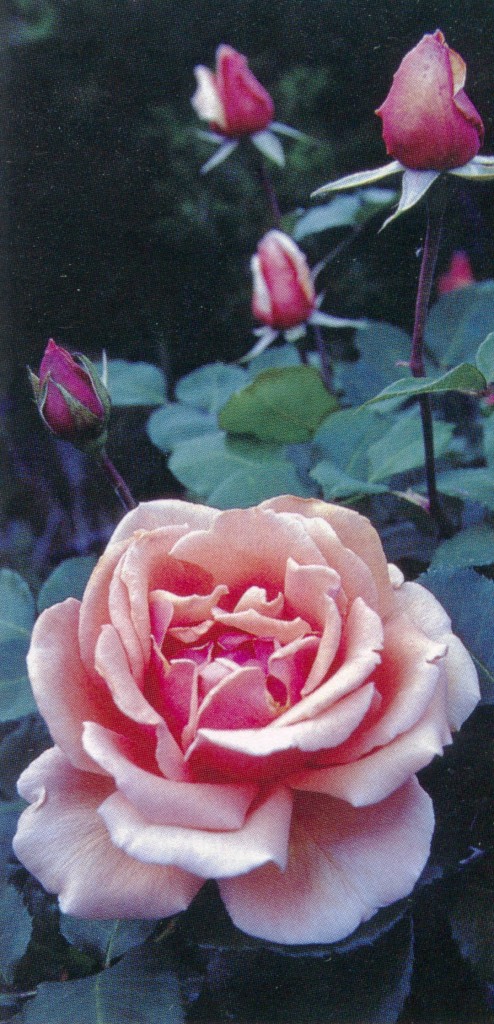
Observations in a Small Garden: Rosa ‘Just Joey’

Contributor
As a child, I avoided planting hybrid roses in my garden and could not appreciate my neighbors’ roses given the effort needed to keep them healthy and attractive. Admittedly, Michigan’s humid summers encouraged the spread of all sorts of diseases and not a few pests.
After nearly three decades in California, however, I’ve developed a love for roses of all types. Here, they can be disease free, without all the preemptive chemical sprays necessary elsewhere, if care is given to select those that are best adapted to the location in which they will be grown.
I only have three roses at the moment, two of which came with the garden: ‘Mermaid’ and ‘Golden Showers’ survive and flower well with no attention, high on the slope of my east-facing garden. I tire of the thorniness of ‘Mermaid’, but cherish her pale lemon flowers. Though I’m less enthusiastic about the color of ‘Golden Showers’, its persistence is much appreciated; it flowers nearly year-round, and provides the uphill neighbor with plenty of cut flowers and colorful hips.
Some years ago, I fell in love with the hybrid tea ‘Just Joey’, both for his floral color (apricot) and for his fragrance—a luscious fruity aroma that carries well. I enjoyed one for several years in a container and found it relatively carefree.

In January 2003, I planted ‘Just Joey’ again, this time in the ground as a standard, positioned where I could enjoy the voluptuous flowers from my office window. Spring was uncommonly damp—in fact, it was wet! Heavy rains continued later in the season than usual, the skies seldom cleared, and the humidity remained higher than is typical for San Francisco’s fog-free neighborhoods. ‘Just Joey’ just sulked, his foliage plagued with diseases I had never seen before. Aphids swarmed to every leaf and bud, and the flowers never lived up to my memory of them.
I use no chemicals in the garden and wanted to avoid spraying aphids and leaves with anything. I pulled most of the leaves off at one point, hoping a replacement set would be healthier. ‘Just Joey’ struggled through that first year, but I watered him deeply and regularly to get his roots established. In midwinter, I pruned him heavily and hoped for healthy new growth in the following season.
March of 2004 was the hottest on record in San Francisco, temperatures hovering above 80° F for at least ten days. The rains disappeared early, after a record-setting downpour in the second week. The ground was thoroughly moistened, but the air was dry—perfect for roses. In early April, ‘Just Joey ‘ developed his first ten flower buds, each rising on a sturdy stem above perfect foliage. Close observation revealed one bud nearly covered with aphids and a second with about ten, but the remaining buds were totally free of pests. I decided to do nothing but wait and watch.
After three days, the bud with only a few aphids was almost free of them; I rubbed out the remaining ones with my fingers. The bud with lots of aphids had fewer—perhaps down by half—along with the carcasses of dead aphids. None of the other buds attracted any aphids at all. The foliage still looked superb. Before the first flower opened, all aphids had gone—completely! (I never discovered the predator or parasite responsible for the aphids’ disappearance.)
April’s unusual hot spell (91° F in San Francisco) forced all ten buds to open within a two-day period. The flowers were perfect, albeit short-lived due to the record heat. The spring flush of bloom lasted barely more than a week. After deadheading, the foliage remained spotless. Soon new shoots appeared, providing assurance of another crop of fragrant blossoms.
I checked with Lucy Tolmach, head gardener at Filoli, where hundreds of hybrid roses are grown in formal beds. Lucy stopped using chemicals on their roses about eight years ago and has been systematically eliminating from the collection any roses that simply did not thrive under this new regimen. She confirmed that ‘Just Joey’ is among her top roses for fragrance and disease resistance, at least in this part of California. She also commented that it usually takes a rose three years to “settle in.”
I’ll continue to observe my own ‘Just Joey’, watering deeply occasionally, pruning in season, and avoiding any preemptive pest control. His third and future seasons should be spectacular.
I have room for one more rose in the garden, but it has to be a climber with a long season of bloom, apricot flowers, fragrance, and disease-free foliage. I’ve settled on ‘Crépuscule’, which thrives in our mild mediterranean climate. Stay tuned…
RGT
Share:
Social Media
Garden Futurist Podcast
Most Popular
Videos
Topics
Related Posts

Low Maintenance Gardens – Better for Pollinators and People
Autumn 2022 “I come out every day. It’s therapy, my meditation.” Janet’s young garden transformed from overgrown, invasive plants to mostly natives. The dailiness of

Calochortophilia: A Californian’s Love Affair with a Genus
Summer 2022 I can chart the progression of my life by Calochortus. For the last two decades, at least. As a teenage girl growing up

Pacific Plant People: Carol Bornstein
Spring 2022 Public gardens play a key role in demonstrating naturalistic planting design, selecting native and adapted plants for habitat, and testing techniques for reducing

Add Year-Round Interest and Winter Blooms for Pollinators
Spring 2022 This article was created from an Interview by Merrill Jensen with Neil Bell in the Summer of 2021 for our Pacific Plant People










Responses